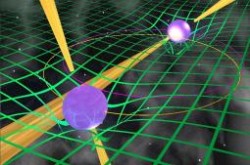The gravity of the Earth is a tough thing to escape, but breaking free from the gravity of the Sun is on a whole other level. But humans have achieved this amazing accomplishment, and right now there are several spacecraft leaving the Solar System and never coming back.
Solar System Guide
The Universe is a very big place, and we occupy a very small corner of it. Known as the Solar System, our stomping grounds are not only a tiny fraction of the Universe as we know it, but is also a very small part of our galactic neighborhood (aka. the Milky Way Galaxy). When it comes right down to it, our world is just a drop of water in an endless cosmic sea.
Nevertheless, the Solar System is still a very big place, and one which is filled with its fair share of mysteries. And in truth, it was only within the relatively recent past that we began to understand its true extent. And when it comes to exploring it, we’ve really only begun to scratch the surface.
Discovery:
With very few exceptions, few people or civilizations before the era of modern astronomy recognized the Solar System for what it was. In fact, the vast majority of astronomical systems posited that the Earth was a stationary object and that all known celestial objects revolved around it. In addition, they viewed it as being fundamentally different from other stellar objects, which they held to be ethereal or divine in nature.
Although there were some Greek, Arab and Asian astronomers during Antiquity and the Medieval period who believed that the universe was heliocentric in nature (i.e. that the Earth and other bodies revolved around the Sun) it was not until Nicolaus Copernicus developed his mathematically predictive model of a heliocentric system in the 16th century that it began to become widespread.

During the 17th-century, scientists like Galileo Galilei, Johannes Kepler, and Isaac Newton developed an understanding of physics which led to the gradual acceptance that the Earth revolves round the Sun. The development of theories like gravity also led to the realization that the other planets are governed by the same physical laws as Earth.
The widespread use of the telescope also led to a revolution in astronomy. After Galileo discovered the moons of Jupiter in 1610, Christian Huygens would go on to discover that Saturn also had moons in 1655. In time, new planets would also be discovered (such as Uranus and Neptune), as well as comets (such as Halley’s Comet) and the Asteroids Belt.
By the 19th century, three observations made by three separate astronomers determined the true nature of the Solar System and its place the universe. The first was made in 1839 by German astronomer Friedrich Bessel, who successfully measured an apparent shift in the position of a star created by the Earth’s motion around the Sun (aka. stellar parallax). This not only confirmed the heliocentric model beyond a doubt, but revealed the vast distance between the Sun and the stars.
In 1859, Robert Bunsen and Gustav Kirchhoff (a German chemist and physicist) used the newly invented spectroscope to examined the spectral signature of the Sun. They discovered that it was composed of the same elements as existed on Earth, thus proving that Earth and the heavens were composed of the same elements.

Then, Father Angelo Secchi – an Italian astronomer and director at the Pontifical Gregorian University – compared the spectral signature of the Sun with those of other stars, and found them to be virtually identical. This demonstrated conclusively that our Sun was composed of the same materials as every other star in the universe.
Further apparent discrepancies in the orbits of the outer planets led American astronomer Percival Lowell to conclude that yet another planet, which he referred to as “Planet X“, must lie beyond Neptune. After his death, his Lowell Observatory conducted a search that ultimately led to Clyde Tombaugh’s discovery of Pluto in 1930.
Also in 1992, astronomers David C. Jewitt of the University of Hawaii and Jane Luu of the MIT discovered the Trans-Neptunian Object (TNO) known as (15760) 1992 QB1. This would prove to be the first of a new population, known as the Kuiper Belt, which had already been predicted by astronomers to exist at the edge of the Solar System.
Further investigation of the Kuiper Belt by the turn of the century would lead to additional discoveries. The discovery of Eris and other “plutoids” by Mike Brown, Chad Trujillo, David Rabinowitz and other astronomers would lead to the Great Planet Debate – where IAU policy and the convention for designating planets would be contested.
Structure and Composition:
At the core of the Solar System lies the Sun (a G2 main-sequence star) which is then surrounded by four terrestrial planets (the Inner Planets), the main Asteroid Belt, four gas giants (the Outer Planets), a massive field of small bodies that extends from 30 AU to 50 AU from the Sun (the Kuiper Belt). The system is then surrounded a spherical cloud of icy planetesimals (the Oort Cloud) that is believed to extend to a distance of 100,000 AU from the Sun into the Interstellar Medium.
The Sun contains 99.86% of the system’s known mass, and its gravity dominates the entire system. Most large objects in orbit around the Sun lie near the plane of Earth’s orbit (the ecliptic) and most planets and bodies rotate around it in the same direction (counter-clockwise when viewed from above Earth’s north pole). The planets are very close to the ecliptic, whereas comets and Kuiper belt objects are frequently at greater angles to it.
It’s four largest orbiting bodies (the gas giants) account for 99% of the remaining mass, with Jupiter and Saturn together comprising more than 90%. The remaining objects of the Solar System (including the four terrestrial planets, the dwarf planets, moons, asteroids, and comets) together comprise less than 0.002% of the Solar System’s total mass.
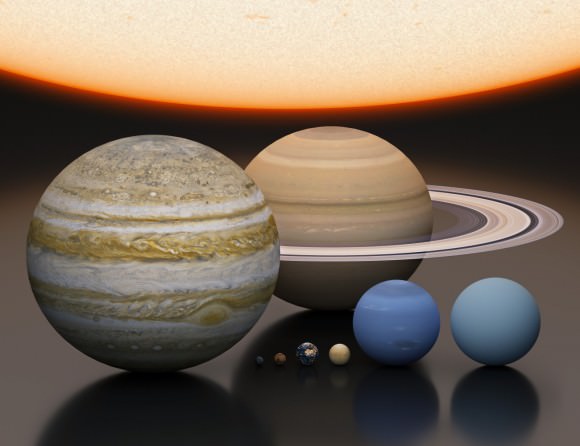
Astronomers sometimes informally divide this structure into separate regions. First, there is the Inner Solar System, which includes the four terrestrial planets and the Asteroid Belt. Beyond this, there’s the outer Solar System that includes the four gas giant planets. Meanwhile, there’s the outermost parts of the Solar System are considered a distinct region consisting of the objects beyond Neptune (i.e. Trans-Neptunian Objects).
Most of the planets in the Solar System possess secondary systems of their own, being orbited by planetary objects called natural satellites (or moons). In the case of the four giant planets, there are also planetary rings – thin bands of tiny particles that orbit them in unison. Most of the largest natural satellites are in synchronous rotation, with one face permanently turned toward their parent.
The Sun, which comprises nearly all the matter in the Solar System, is composed of roughly 98% hydrogen and helium. The terrestrial planets of the Inner Solar System are composed primarily of silicate rock, iron and nickel. Beyond the Asteroid Belt, planets are composed mainly of gases (such as hydrogen, helium) and ices – like water, methane, ammonia, hydrogen sulfide and carbon dioxide.
Objects farther from the Sun are composed largely of materials with lower melting points. Icy substances comprise the majority of the satellites of the giant planets, as well as most of Uranus and Neptune (hence why they are sometimes referred to as “ice giants”) and the numerous small objects that lie beyond Neptune’s orbit.
Together, gases and ices are referred to as volatiles. The boundary in the Solar System beyond which those volatile substances could condense is known as the frost line, which lies roughly 5 AU from the Sun. Within the Kuiper Belt, objects and planetesimals are composed mainly of these materials and rock.
Formation and Evolution:
The Solar System formed 4.568 billion years ago from the gravitational collapse of a region within a large molecular cloud composed of hydrogen, helium, and small amounts of heavier elements fused by previous generations of stars. As the region that would become the Solar System (known as the pre-solar nebula) collapsed, conservation of angular momentum caused it to rotate faster.
The center, where most of the mass collected, became increasingly hotter than the surrounding disc. As the contracting nebula rotated faster, it began to flatten into a protoplanetary disc with a hot, dense protostar at the center. The planets formed by accretion from this disc, in which dust and gas gravitated together and coalesced to form ever larger bodies.
Due to their higher boiling points, only metals and silicates could exist in solid form closer to the Sun, and these would eventually form the terrestrial planets of Mercury, Venus, Earth, and Mars. Because metallic elements only comprised a very small fraction of the solar nebula, the terrestrial planets could not grow very large.
In contrast, the giant planets (Jupiter, Saturn, Uranus, and Neptune) formed beyond the point between the orbits of Mars and Jupiter where material is cool enough for volatile icy compounds to remain solid (i.e. the frost line).
The ices that formed these planets were more plentiful than the metals and silicates that formed the terrestrial inner planets, allowing them to grow massive enough to capture large atmospheres of hydrogen and helium. Leftover debris that never became planets congregated in regions such as the asteroid belt, Kuiper belt, and Oort cloud.
Within 50 million years, the pressure and density of hydrogen in the center of the protostar became great enough for it to begin thermonuclear fusion. The temperature, reaction rate, pressure, and density increased until hydrostatic equilibrium was achieved.
At this point, the Sun became a main-sequence star. Solar wind from the Sun created the heliosphere and swept away the remaining gas and dust from the protoplanetary disc into interstellar space, ending the planetary formation process.
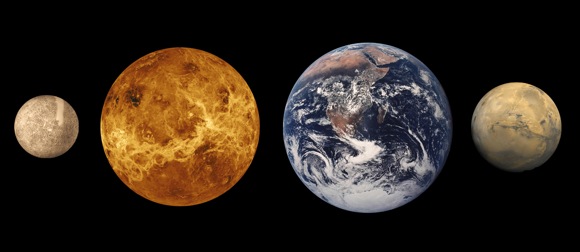
The Solar System will remain roughly as we know it today until the hydrogen in the core of the Sun has been entirely converted to helium. This will occur roughly 5 billion years from now and mark the end of the Sun’s main-sequence life. At this time, the core of the Sun will collapse, and the energy output will be much greater than at present.
The outer layers of the Sun will expand to roughly 260 times its current diameter, and the Sun will become a red giant. The expanding Sun is expected to vaporize Mercury and Venus and render Earth uninhabitable as the habitable zone moves out to the orbit of Mars. Eventually, the core will be hot enough for helium fusion and the Sun will burn helium for a time, after which nuclear reactions in the core will start to dwindle.
At this point, the Sun’s outer layers will move away into space, leaving a white dwarf – an extraordinarily dense object that will have half the original mass of the Sun, but will be the size of Earth. The ejected outer layers will form what is known as a planetary nebula, returning some of the material that formed the Sun to the interstellar medium.
Inner Solar System:
In the inner Solar System, we find the “Inner Planets” – Mercury, Venus, Earth, and Mars – which are so named because they orbit closest to the Sun. In addition to their proximity, these planets have a number of key differences that set them apart from planets elsewhere in the Solar System.
For starters, the inner planets are rocky and terrestrial, composed mostly of silicates and metals, whereas the outer planets are gas giants. The inner planets are also much more closely spaced than their outer Solar System counterparts. In fact, the radius of the entire region is less than the distance between the orbits of Jupiter and Saturn.
Generally, inner planets are smaller and denser than their counterparts, and have few to no moons or rings circling them. The outer planets, meanwhile, often have dozens of satellites and rings composed of particles of ice and rock.
The terrestrial inner planets are composed largely of refractory minerals such as the silicates, which form their crusts and mantles, and metals such as iron and nickel which form their cores. Three of the four inner planets (Venus, Earth and Mars) have atmospheres substantial enough to generate weather. All of them have impact craters and tectonic surface features as well, such as rift valleys and volcanoes.
Of the inner planets, Mercury is the closest to our Sun and the smallest of the terrestrial planets. Its magnetic field is only about 1% that of Earth’s, and it’s very thin atmosphere means that it is hot during the day (up to 430°C) and freezing at night (as low as -187 °C) because the atmosphere can neither keep heat in or out. It has no moons of its own and is comprised mostly of iron and nickel. Mercury is one of the densest planets in the Solar System.
Venus, which is about the same size as Earth, has a thick toxic atmosphere that traps heat, making it the hottest planet in the Solar System. This atmosphere is composed of 96% carbon dioxide, along with nitrogen and a few other gases. Dense clouds within Venus’ atmosphere are composed of sulphuric acid and other corrosive compounds, with very little water. Much of Venus’ surface is marked with volcanoes and deep canyons – the biggest of which is over 6400 km (4,000 mi) long.
Earth is the third inner planet and the one we know best. Of the four terrestrial planets, Earth is the largest, and the only one that currently has liquid water, which is necessary for life as we know it. Earth’s atmosphere protects the planet from dangerous radiation and helps keep valuable sunlight and warmth in, which is also essential for life to survive.
Like the other terrestrial planets, Earth has a rocky surface with mountains and canyons, and a heavy metal core. Earth’s atmosphere contains water vapor, which helps to moderate daily temperatures. Like Mercury, the Earth has an internal magnetic field. And our Moon, the only one we have, is comprised of a mixture of various rocks and minerals.

Mars is the fourth and final inner planet, and is also known as the “Red Planet” due to the oxidization of iron-rich materials that form the planet’s surface. Mars also has some of the most interesting terrain features of any of the terrestrial planets. These include the largest mountain in the Solar System (Olympus Mons) which rises some 21,229 m (69,649 ft) above the surface, and a giant canyon called Valles Marineris – which is 4000 km (2500 mi) long and reaches depths of up to 7 km (4 mi).
Much of Mars’ surface is very old and filled with craters, but there are geologically newer areas of the planet as well. At the Martian poles are polar ice caps that shrink in size during the Martian spring and summer. Mars is less dense than Earth and has a smaller magnetic field, which is indicative of a solid core, rather than a liquid one.
Mars’ thin atmosphere has led some astronomers to believe that the surface water that once existed there might have actually taken liquid form, but has since evaporated into space. The planet has two small moons called Phobos and Deimos.
Outer Solar System:
The outer planets (sometimes called Jovian planets or gas giants) are huge planets swaddled in gas that have rings and plenty of moons. Despite their size, only two of them are visible without telescopes: Jupiter and Saturn. Uranus and Neptune were the first planets discovered since antiquity, and showed astronomers that the solar system was bigger than previously thought.

Jupiter is the largest planet in our Solar System and spins very rapidly (10 Earth hours) relative to its orbit of the sun (12 Earth years). Its thick atmosphere is mostly made up of hydrogen and helium, perhaps surrounding a terrestrial core that is about Earth’s size. The planet has dozens of moons, some faint rings and a Great Red Spot – a raging storm that has happening for the past 400 years at least.
Saturn is best known for its prominent ring system – seven known rings with well-defined divisions and gaps between them. How the rings got there is one subject under investigation. It also has dozens of moons. Its atmosphere is mostly hydrogen and helium, and it also rotates quickly (10.7 Earth hours) relative to its time to circle the Sun (29 Earth years).
Uranus was first discovered by William Herschel in 1781. The planet’s day takes about 17 Earth hours and one orbit around the Sun takes 84 Earth years. Its mass contains water, methane, ammonia, hydrogen and helium surrounding a rocky core. It has dozens of moons and a faint ring system. The only spacecraft to visit this planet was the Voyager 2 spacecraft in 1986.
Neptune is a distant planet that contains water, ammmonia, methane, hydrogen and helium and a possible Earth-sized core. It has more than a dozen moons and six rings. NASA’s Voyager 2 spacecraft also visited this planet and its system by 1989 during its transit of the outer Solar System.
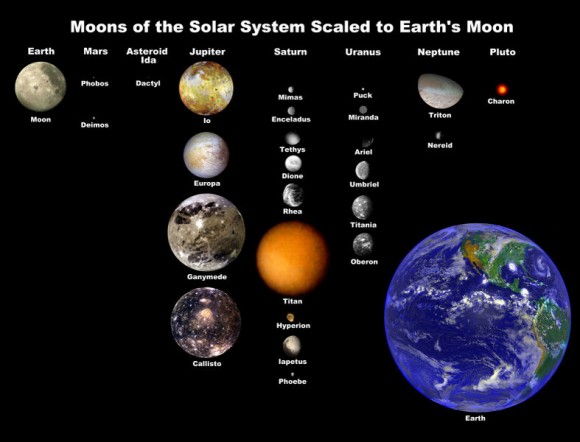
Trans-Neptunian Region:
There have been more than a thousand objects discovered in the Kuiper Belt, and it’s theorized that there are as many as 100,000 objects larger than 100 km in diameter. Given to their small size and extreme distance from Earth, the chemical makeup of KBOs is very difficult to determine.
However, spectrographic studies conducted of the region since its discovery have generally indicated that its members are primarily composed of ices: a mixture of light hydrocarbons (such as methane), ammonia, and water ice – a composition they share with comets. Initial studies also confirmed a broad range of colors among KBOs, ranging from neutral grey to deep red.
This suggests that their surfaces are composed of a wide range of compounds, from dirty ices to hydrocarbons. In 1996, Robert H. Brown et al. obtained spectroscopic data on the KBO 1993 SC, revealing its surface composition to be markedly similar to that of Pluto (as well as Neptune’s moon Triton) in that it possessed large amounts of methane ice.
Water ice has been detected in several KBOs, including 1996 TO66, 38628 Huya and 20000 Varuna. In 2004, Mike Brown et al. determined the existence of crystalline water ice and ammonia hydrate on one of the largest known KBOs, 50000 Quaoar. Both of these substances would have been destroyed over the age of the Solar System, suggesting that Quaoar had been recently resurfaced, either by internal tectonic activity or by meteorite impacts.
Keeping Pluto company out in the Kuiper belt are many other objects worthy of mention. Quaoar, Makemake, Haumea, Orcus and Eris are all large icy bodies in the Belt and several of them even have moons of their own. These are all tremendously far away, and yet, very much within reach.
Oort Cloud and Farthest Regions:
The Oort Cloud is thought to extend from between 2,000 and 5,000 AU (0.03 and 0.08 ly) to as far as 50,000 AU (0.79 ly) from the Sun, though some estimates place the outer edge as far as 100,000 and 200,000 AU (1.58 and 3.16 ly). The Cloud is thought to be comprised of two regions – a spherical outer Oort Cloud of 20,000 – 50,000 AU (0.32 – 0.79 ly), and disc-shaped inner Oort (or Hills) Cloud of 2,000 – 20,000 AU (0.03 – 0.32 ly).
The outer Oort cloud may have trillions of objects larger than 1 km (0.62 mi), and billions that measure 20 kilometers (12 mi) in diameter. Its total mass is not known, but – assuming that Halley’s Comet is a typical representation of outer Oort Cloud objects – it has the combined mass of roughly 3×1025 kilograms (6.6×1025 pounds), or five Earths.
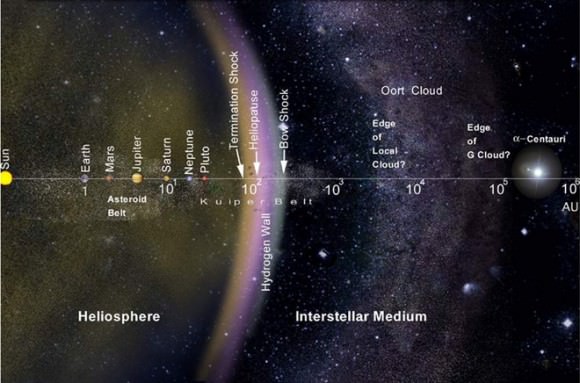
Based on the analyses of past comets, the vast majority of Oort Cloud objects are composed of icy volatiles – such as water, methane, ethane, carbon monoxide, hydrogen cyanide, and ammonia. The appearance of asteroids thought to be originating from the Oort Cloud has also prompted theoretical research that suggests that the population consists of 1-2% asteroids.
Earlier estimates placed its mass up to 380 Earth masses, but improved knowledge of the size distribution of long-period comets has led to lower estimates. The mass of the inner Oort Cloud, meanwhile, has yet to be characterized. The contents of both Kuiper Belt and the Oort Cloud are known as Trans-Neptunian Objects (TNOs), because the objects of both regions have orbits that that are further from the Sun than Neptune’s orbit.
Exploration:
Our knowledge of the Solar System also benefited immensely from the advent of robotic spacecraft, satellites, and robotic landers. Beginning in the mid-20th century, in what was known as “The Space Age“, manned and robotic spacecraft began exploring planets, asteroids and comets in the Inner and Outer Solar System.
All planets in the Solar System have now been visited to varying degrees by spacecraft launched from Earth. Through these unmanned missions, humans have been able to get close-up photographs of all the planets. In the case of landers and rovers, tests have been performed on the soils and atmospheres of some.
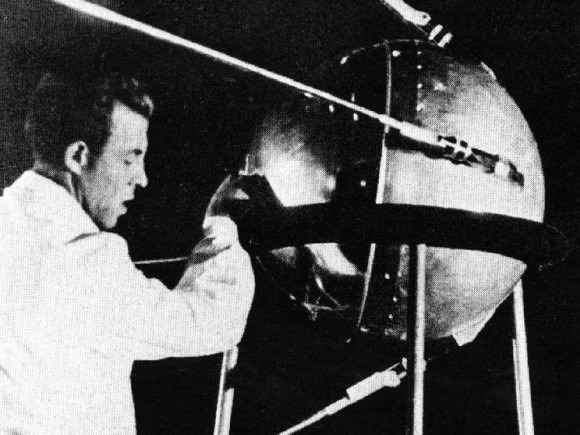
The first artificial object sent into space was the Soviet satellite Sputnik 1, which was launched in space in 1957, successfully orbited the Earth for months, and collected information on the density of the upper atmosphere and the ionosphere. The American probe Explorer 6, launched in 1959, was the first satellite to capture images of the Earth from space.
Robotic spacecraft conducting flybys also revealed considerable information about the planet’s atmospheres, geological and surface features. The first successful probe to fly by another planet was the Soviet Luna 1 probe, which sped past the Moon in 1959. The Mariner program resulted in multiple successful planetary flybys, consisting of the Mariner 2 mission past Venus in 1962, the Mariner 4 mission past Mars in 1965, and the Mariner 10 mission past Mercury in 1974.
By the 1970’s, probes were being dispatched to the outer planets as well, beginning with the Pioneer 10 mission which flew past Jupiter in 1973 and the Pioneer 11 visit to Saturn in 1979. The Voyager probes performed a grand tour of the outer planets following their launch in 1977, with both probes passing Jupiter in 1979 and Saturn in 1980-1981. Voyager 2 then went on to make close approaches to Uranus in 1986 and Neptune in 1989.
Launched on January 19th, 2006, the New Horizons probe is the first man-made spacecraft to explore the Kuiper Belt. This unmanned mission flew by Pluto in July 2015. Should it prove feasible, the mission will also be extended to observe a number of other Kuiper Belt Objects (KBOs) in the coming years.
Orbiters, rovers, and landers began being deployed to other planets in the Solar System by the 1960’s. The first was the Soviet Luna 10 satellite, which was sent into lunar orbit in 1966. This was followed in 1971 with the deployment of the Mariner 9 space probe, which orbited Mars, and the Soviet Venera 9 which orbited Venus in 1975.
The Galileo probe became the first artificial satellite to orbit an outer planet when it reached Jupiter in 1995, followed by the Cassini–Huygens probe orbiting Saturn in 2004. Mercury and Vesta were explored by 2011 by the MESSENGER and Dawn probes, respectively, with Dawn establishing orbit around the asteroid/dwarf planet Ceres in 2015.
The first probe to land on another Solar System body was the Soviet Luna 2 probe, which impacted the Moon in 1959. Since then, probes have landed on or impacted on the surfaces of Venus in 1966 (Venera 3), Mars in 1971 (Mars 3 and Viking 1 in 1976), the asteroid 433 Eros in 2001 (NEAR Shoemaker), and Saturn’s moon Titan (Huygens) and the comet Tempel 1 (Deep Impact) in 2005.
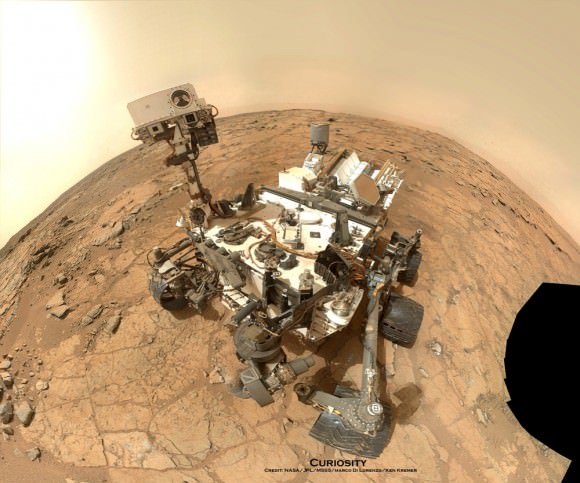
To date, only two worlds in the Solar System, the Moon and Mars, have been visited by mobile rovers. The first robotic rover to land on another planet was the Soviet Lunokhod 1, which landed on the Moon in 1970. The first to visit another planet was Sojourner, which traveled 500 meters across the surface of Mars in 1997, followed by Spirit (2004), Opportunity (2004), and Curiosity (2012).
Manned missions into space began in earnest in the 1950’s, and was a major focal point for both the United States and Soviet Union during the “Space Race“. For the Soviets, this took the form of the Vostok program, which involved sending manned space capsules into orbit.
The first mission – Vostok 1 – took place on April 12th, 1961, and was piloted by Soviet cosmonaut Yuri Gagarin (the first human being to go into space). On June 6th, 1963, the Soviets also sent the first woman – Valentina Tereshvoka – into space as part of the Vostok 6 mission.
In the US, Project Mercury was initiated with the same goal of placing a crewed capsule into orbit. On May 5th, 1961, astronaut Alan Shepard went into space aboard the Freedom 7 mission and became the first American (and second human) to go into space.
After the Vostok and Mercury programs were completed, the focus of both nations and space programs shifted towards the development of two and three-person spacecraft, as well as the development of long-duration spaceflights and extra-vehicular activity (EVA).
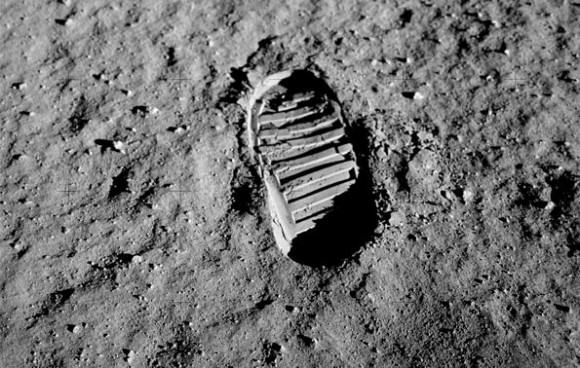
This took the form of the Voshkod and Gemini programs in the Soviet Union and US, respectively. For the Soviets, this involved developing a two to three-person capsule, whereas the Gemini program focused on developing the support and expertise needed for an eventual manned mission to the Moon.
These latter efforts culminated on July 21st, 1969 with the Apollo 11 mission, when astronauts Neil Armstrong and Buzz Aldrin became the first men to walk on the Moon. As part of the Apollo program, five more Moon landings would take place through 1972, and the program itself resulted in many scientific packages being deployed on the Lunar surface, and samples of moon rocks being returned to Earth.
After the Moon Landing took place, the focus of the US and Soviet space programs then began to shift to the development of space stations and reusable spacecraft. For the Soviets, this resulted in the first crewed orbital space stations dedicated to scientific research and military reconnaissance – known as the Salyut and Almaz space stations.
The first orbital space station to host more than one crew was NASA’s Skylab, which successfully held three crews from 1973 to 1974. The first true human settlement in space was the Soviet space station Mir, which was continuously occupied for close to ten years, from 1989 to 1999. It was decommissioned in 2001, and its successor, the International Space Station, has maintained a continuous human presence in space since then.

The United States’ Space Shuttle, which debuted in 1981, became the only reusable spacecraft to successfully make multiple orbital flights. The five shuttles that were built (Atlantis, Endeavour, Discovery, Challenger, Columbia and Enterprise) flew a total of 121 missions before being decommissioned in 2011.
During their history of service, two of the craft were destroyed in accidents. These included the Space Shuttle Challenger – which exploded upon take-off on Jan. 28th, 1986 – and the Space Shuttle Columbia which disintegrated during re-entry on Feb. 1st, 2003.
In 2004, then-U.S. President George W. Bush announced the Vision for Space Exploration, which called for a replacement for the aging Shuttle, a return to the Moon and, ultimately, a manned mission to Mars. These goals have since been maintained by the Obama administration, and now include plans for an Asteroid Redirect mission, where a robotic craft will tow an asteroid closer to Earth so a manned mission can be mounted to it.
All the information gained from manned and robotic missions about the geological phenomena of other planets – such as mountains and craters – as well as their seasonal, meteorological phenomena (i.e. clouds, dust storms and ice caps) have led to the realization that other planets experience much the same phenomena as Earth. In addition, it has also helped scientists to learn much about the history of the Solar System and its formation.
As our exploration of the Inner and Outer Solar System has improved and expanded, our conventions for categorizing planets has also changed. Our current model of the Solar System includes eight planets (four terrestrial, four gas giants), four dwarf planets, and a growing number of Trans-Neptunian Objects that have yet to be designated. It also contains and is surrounded by countless asteroids and planetesimals.
Given its sheer size, composition and complexity, researching our Solar System in full detail would take an entire lifetime. Obviously, no one has that kind of time to dedicate to the topic, so we have decided to compile the many articles we have about it here on Universe Today in one simple page of links for your convenience.
There are thousands of facts about the solar system in the links below. Enjoy your research.
The Solar System:
- Interesting Facts About the Solar System
- Our Solar System
- What is the Solar System?
- How Big is the Solar System?
- Diameter of the Solar System
- Solar System Orbits
- How Old is the Solar System?
- Stars and Planets
- All About Planets
- Inner Solar System
- Beyond the Solar System
- Solar System, Galaxy, Universe
- Diagram of the Solar System
- New Solar System
- Solar System Order
- Oort Cloud
- Interplanetary Space
- Plane of the Ecliptic
- Planetesimals
- Deep Space
- Protoplanets
- Planetoid
- Nemesis
Theories about the Solar System:
- Formation of the Solar System
- How Was the Solar System Formed?
- Origin of the Solar System
- Solar Nebula
- Solar Disruption Theory
- Solar Nebula Theory
- Geocentric Theory
- Geocentric Model
- Heliocentric Model
- Difference Between Geocentric and Heliocentric
Moons:
Anything EXTREME!:
- How Many Stars are in the Solar System?
- Largest Volcano in the Solar System
- What is the Largest Moon in the Solar System?
- What is the Smallest Moon in the Solar System?
- Largest in the Solar System
Solar System Stuffs:
Tricks to Remember the Planets
Need an easy way to remember the order of the planets in our Solar System? The technique used most often to remember such a list is a mnemonic device. This uses the first letter of each planet as the first letter of each word in a sentence. Supposedly, experts say, the sillier the sentence, the easier it is to remember.
So by using the first letters of the planets, (Mercury, Venus, Earth, Mars, Jupiter, Saturn, Uranus, and Neptune), create a silly but memorable sentence.
Here are a few examples:
- My Very Excellent Mother Just Served Us Noodles (or Nachos)
- Mercury’s Volcanoes Erupt Mulberry Jam Sandwiches Until Noon
- Very Elderly Men Just Snooze Under Newspapers
- My Very Efficient Memory Just Summed Up Nine
- My Very Easy Method Just Speeds Up Names
- My Very Expensive Malamute Jumped Ship Up North

The Sun and planets to scale. Credit: Illustration by Judy Schmidt, texture maps by Björn Jónsson If you want to remember the planets in order of size, (Jupiter, Saturn, Uranus, Neptune, Earth, Venus Mars, Mercury) you can create a different sentence:
- Just Sit Up Now Each Monday Morning
- Jack Sailed Under Neath Every Metal Mooring
Rhymes are also a popular technique, albeit they require memorizing more words. But if you’re a poet (and don’t know it) try this:
Amazing Mercury is closest to the Sun,
Hot, hot Venus is the second one,
Earth comes third: it’s not too hot,
Freezing Mars awaits an astronaut,
Jupiter is bigger than all the rest,
Sixth comes Saturn, its rings look best,
Uranus sideways falls and along with Neptune, they are big gas balls.Or songs can work too. Here are a couple of videos that use songs to remember the planets:
If sentences, rhymes or songs don’t work for you, perhaps you are more of a visual learner, as some people remember visual cues better than words. Try drawing a picture of the planets in order. You don’t have to be an accomplished artist to do this; you can simply draw different circles for each planet and label each one. Sometimes color-coding can help aid your memory. For example, use red for Mars and blue for Neptune. Whatever you decide, try to pick colors that are radically different to avoid confusing them.
Or try using Solar System flash cards or just pictures of the planets printed on a page (here are some great pictures of the planets). This works well because not only are you recalling the names of the planets but also what they look like. Memory experts say the more senses you involve in learning or storing something, the better you will be at recalling it.

Planets made from paper lanterns. Credit: TheSweetestOccasion.com Maybe you are a hands-on learner. If so, try building a three-dimensional model of the Solar System. Kids, ask your parents or guardians to help you with this, or parents/guardians, this is a fun project to do with your children. You can buy inexpensive Styrofoam balls at your local craft store to create your model, or use paper lanterns and decorate them. Here are several ideas from Pinterest on building a 3-D Solar System Model.
If you are looking for a group project to help a class of children learn the planets, have a contest to see who comes up with the silliest sentence to remember the planets. Additionally, you can have eight children act as the planets while the rest of the class tries to line them up in order. You can find more ideas on NASA’s resources for Educators. You can use these tricks as a starting point and find more ways of remembering the planets that work for you.
If you are looking for more information on the planets check out Universe Today’s Guide to the Planets section, or our article about the Order of the Planets, or this information from NASA on the planets and a tour of the planets.
Universe Today has numerous articles on the planets including the planets and list of the planets.
Astronomy Cast has an entire series of episodes on the planets. You can get started with Mercury.
What is the Earth’s Average Temperature?
Earth is the only planet in our Solar System where life is known to exists. Note the use of the word “known”, which is indicative of the fact that our knowledge of the Solar System is still in its infancy, and the search for life continues. However, from all observable indications, Earth is the only place in our Solar System where life can – and does – exist on the surface.
This is due to a number of factors, which include Earth’s position relative to the Sun. Being in the “Goldilocks Zone” (aka. habitable zone), and the existence of an atmosphere (and magnetosphere), Earth is able to maintain a stable average temperature on its surface that allows for the existence of warm, flowing water on its surface, and conditions favorable to life.
Variations:
The average temperature on the surface of Earth depends on a number of factors. These include the time of day, the time of year, and where the temperatures measurements are being taken. Given that the Earth experiences a sidereal rotation of approximately 24 hours – which means one side is never always facing towards the Sun – temperatures rise in the day and drop in the evening, sometimes substantially.
And given that Earth has an inclined axis (approximately 23° towards the Sun’s equator), the Northern and Southern Hemispheres of Earth are either tilted towards or away from the Sun during the summer and winter seasons, respectively. And given that equatorial regions of the Earth are closer to the Sun, and certain parts of the world experience more sunlight and less cloud cover, temperatures range widely across the planet.
However, not every region on the planet experiences four seasons. At the equator, the temperature is on average higher and the region does not experience cold and hot seasons in the same way the Northern and Southern Hemispheres do. This is because the amount of sunlight the reaches the equator changes very little, although the temperatures do vary somewhat during the rainy season.
Measurement:
The average surface temperature on Earth is approximately 14°C; but as already noted, this varies. For instance, the hottest temperature ever recorded on Earth was 70.7°C (159°F), which was taken in the Lut Desert of Iran. These measurements were part of a global temperature survey conducted by scientists at NASA’s Earth Observatory during the summers of 2003 to 2009. For five of the seven years surveyed (2004, 2005, 2006, 2007, and 2009) the Lut Desert was the hottest spot on Earth.
However, it was not the hottest spot for every single year in the survey. In 2003, the satellites recorded a temperature of 69.3°C (156.7°F) – the second highest in the seven-year analysis – in the shrublands of Queensland, Australia. And in 2008, the Flaming Mountain got its due, with a yearly maximum temperature of 66.8°C (152.2°F) recorded in the nearby Turpan Basin in western China.
Meanwhile, the coldest temperature ever recorded on Earth was measured at the Soviet Vostok Station on the Antarctic Plateau. Using ground-based measurements, the temperature reached a historic low of -89.2°C (-129°F) on July 21st, 1983. Analysis of satellite data indicated a probable temperature of around -93.2 °C (-135.8 °F; 180.0 K), also in Antarctica, on August 10th, 2010. However, this reading was not confirmed by ground measurements, and thus the previous record remains.
All of these measurements were based on temperature readings that were performed in accordance with the World Meteorological Organization standard. By these regulations, air temperature is measured out of direct sunlight – because the materials in and around the thermometer can absorb radiation and affect the sensing of heat – and thermometers are to be situated 1.2 to 2 meters off the ground.
Comparison to Other Planets:
Despite variations in temperature according to time of day, season, and location, Earth’s temperatures are remarkably stable compared to other planets in the Solar System. For instance, on Mercury, temperatures range from molten hot to extremely cold, due to its proximity to the Sun, lack of an atmosphere, and its slow rotation. In short, temperatures can reach up to 465 °C on the side facing the Sun, and drop to -184°C on the side facing away from it.
Venus, thanks to its thick atmosphere of carbon dioxide and sulfur dioxide, is the hottest planet in our Solar System. At its hottest, it can reach temperatures of up to 460 °C on a regular basis. Meanwhile, Mars’ average surface temperature is -55 °C, but the Red Planet also experiences some variability, with temperatures ranging as high as 20 °C at the equator during midday, to as low as -153 °C at the poles.
On average though, it is much colder than Earth, being just on the outer edge of the habitable zone, and because of its thin atmosphere – which is not sufficient to retain heat. In addition, its surface temperature can vary by as much as 20 °C due to Mars’ eccentric orbit around the Sun (meaning that it is closer to the Sun at certain points in its orbit than at others).
Since Jupiter is a gas giant, and has no solid surface, an accurate assessment of it’s “surface temperature” is impossible. But measurements taken from the top of Jupiter’s clouds indicate a temperature of approximately -145°C. Similarly, Saturn is a rather cold gas giant planet, with an average temperature of -178 °Celsius. But because of Saturn’s tilt, the southern and northern hemispheres are heated differently, causing seasonal temperature variation.
Uranus is the coldest planet in our Solar System, with a lowest recorded temperature of -224°C, while temperatures in Neptune’s upper atmosphere reach as low as -218°C. In short, the Solar System runs the gambit from extreme cold to extreme hot, with plenty of variance and only a few places that are temperate enough to sustain life. And of all of those, it is only planet Earth that seems to strike the careful balance required to sustain it perpetually.
Variations Throughout History:
Estimates on the average surface temperature of Earth are somewhat limited due to the fact that temperatures have only been recorded for the past two hundred years. Thus, throughout history the recorded highs and lows have varied considerably. An extreme example of this would during the early history of the Solar System, some 3.75 billion years ago.
At this time, the Sun roughly 25% fainter than it is today, and Earth’s atmosphere was still in the process of formation. Nevertheless, according to some research, it is believed that the Earth’s primordial atmosphere – due to its concentrations of methane and carbon dioxide – could have sustained surface temperatures above freezing.
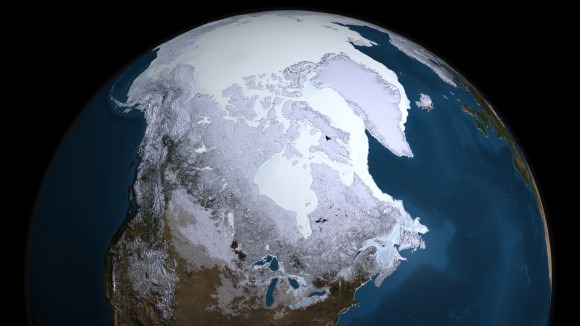
Earth has also undergone periodic climate shifts in the past 2.4 billion years, including five major ice ages – known as the Huronian, Cryogenian, Andean-Saharan, Karoo, and Pliocene-Quaternary, respectively. These consisted of glacial periods where the accumulation of snow and ice increased the surface albedo, more of the Sun’s energy was reflected into space, and the planet maintained a lower atmospheric and average surface temperature.
These periods were separated by “inter-glacial periods”, where increases in greenhouse gases – such as those released by volcanic activity – increased the global temperature and produced a thaw. This process, which is also known as “global warming”, has become a source of controversy during the modern age, where human agency has become a dominant factor in climate change. Hence why some geologists use the term “Anthropocene” to refer to this period.
Thanks to increasing concentrations of CO² and other greenhouses gases, which are generated by human activity, average surface temperatures have been steadily increasing since the mid-20th century. For the past few decades, NASA has been charting average surface temperature increases through the Earth Observatory.
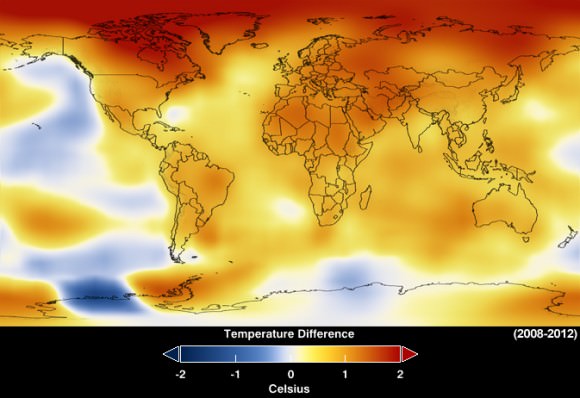
Internal Temperatures:
When talking about the temperatures of planets, there is a major difference between what is measured at the surface and what conditions exist within the planet’s interior. Essentially, the temperature gets cooler the farther one ventures from the core, which is due to the planet’s internal pressure steadily decreasing the father out one goes. And while scientists have never sent a probe to our planet’s core to obtain accurate measurements, various estimates have been made.
For instance, it is believed that the temperature of the Earth’s inner core is as high as 7000 °C, whereas the outer core is thought to be between 4000 and 6000 °C. Meanwhile, the mantle, the region that lies just below the Earth’s outer crust, is estimated to be around 870 °C. And of course, the temperature continues to steadily cool as you rise in the atmosphere.
In the end, temperatures vary considerably on every planet in our Solar System, due to a multitude of factors. But from what we can tell, Earth is alone in that it experiences temperature variations small enough to achieve a degree of stability. Basically, it is the only place we know of that it is both warm enough and cool enough to support life. Everywhere else is just too extreme!
Universe Today has articles on the temperature of Earth and the temperature of the planets. Here are some interesting facts about planet Earth, and here’s an article about why Earth has seasons.
If you’d like more info on Earth, check out NASA’s Solar System Exploration Guide on Earth. And here’s a link to NASA’s Earth Observatory.
For more information, try Earth’s temperature tracker and seasonal temperature cycles.
We’ve also recorded an episode of Astronomy Cast all about planet Earth. Listen here, Episode 51: Earth.
What Is A Dwarf Planet?

The term dwarf planet has been tossed around a lot in recent years. As part of a three-way categorization of bodies orbiting the Sun, the term was adopted in 2006 due to the discovery of objects beyond the orbit of Neptune that were comparable in size to Pluto. Since then, it has come to be used to describe many objects in our Solar System, upending the old classification system that claimed there were nine planets.
The term has also led to its fair share of confusion and controversy, with many questioning its accuracy and applicability to bodies like Pluto. Nevertheless, the IAU currently recognizes five bodies within our Solar System as dwarf planets, six more could be recognized in the coming years, and as many as 200 or more could exist within the expanse of the Kuiper Belt.
Definition:
According to the definition adopted by the IAU in 2006, a dwarf planet is, “a celestial body orbiting a star that is massive enough to be rounded by its own gravity but has not cleared its neighboring region of planetesimals and is not a satellite. More explicitly, it has to have sufficient mass to overcome its compressive strength and achieve hydrostatic equilibrium.”
In essence, the term is meant to designate any planetary-mass object that is neither a planet nor a natural satellite that fits two basic criteria. For one, it must be in direct orbit of the Sun and not be a moon around another body. Second, it must be massive enough for it to have become spherical in shape under its own gravity. And, unlike a planet, it must have not cleared the neighborhood around its orbit.

Size and Mass:
In order for a body to be become rounded, it must be sufficiently massive, to the point that its own gravity is the dominant force effecting it. Here, the internal pressure created by this mass would cause a surface to achieve plasticity, allowing high elevations to sink and hollows to fill in. This does not occur with smaller bodies that are less than a few km in diameter (such as asteroids), which are dominated by forces outside of their own gravity forces and tend to maintain irregular shapes.
Meanwhile, bodies that measure a few kilometers across – where their gravity is more significant but not dominant – tend to be spheroid or “potato-shaped”. The bigger the body is, the higher its internal pressure, until the pressure is sufficient to overcome its internal compressive strength and it achieves hydrostatic equilibrium. At this point, a body is as round as it can possibly be, given its rotation and tidal effects. This is the defining limit of a dwarf planet.
However, rotation can also affect the shape of a dwarf planet. If the body does not rotate, it will be a sphere. But the faster it does rotate, the more oblate or even scalene it becomes. The extreme example of this is Haumea, which is twice as long along its major axis as it is at the poles. Tidal forces also cause a body’s rotation to gradually become tidally locked, such that it always presents the same face to its companion. An extreme example of this is the Pluto-Charon system, where both bodies are tidally locked to each other.
The upper and lower size and mass limits of dwarf planets have not been specified by the IAU. And while the lower limit is defined as the achievement of a hydrostatic equilibrium shape, the size or mass at which an object attains this shape depends on its composition and thermal history.
For example, bodies made of rigid silicates (such as rocky asteroids) should achieve hydrostatic equilibrium at a diameter of approx. 600 km and a mass of 3.4×1020 kg. For a body made of less rigid water ice, the limit would closer to 320 km and 1019 kg. As a result, no specific standard currently exists for defining a dwarf planet based on either its size or mass, but is instead more generally defined based on its shape.
Orbital Dominance:
In addition to hydrostatic equilibrium, many astronomers have insisted that a distinction between planets and dwarf planets be made based on the inability of the latter to “clear the neighborhood around their orbits”. In short, planets are able to remove smaller bodies near their orbits by collision, capture, or gravitational disturbance (or establish orbital resonances that prevent collisions), whereas dwarf planets do not have the requisite mass to do this.
To calculate the likelihood of a planet clearing its orbit, planetary scientists Alan Stern and Harold F. Levison (the former of whom is the principal investigator of the New Horizons mission to Pluto and the Chief Scientist at Moon Express) introduced a parameter they designated as ? (lambda).
This parameter expresses the likelihood of an encounter resulting in a given deflection of an object’s orbit. The value of this parameter in Stern’s model is proportional to the square of the mass and inversely proportional to the period, and can be used to estimate the capacity of a body to clear the neighborhood of its orbit.
Astronomers like Steven Soter, the scientist-in-residence for NYU and a Research Associate at the American Museum of Natural History, have advocated using this parameter to differentiate between planets and dwarf planets. Soter has also proposed a parameter he refers to as the planetary discriminant – designated as µ (mu) – which is calculated by dividing the mass of the body by the total mass of the other objects that share its orbit.
Recognized and Possible Dwarf Planets:
There are currently five dwarf planets: Pluto, Eris, Makemake, Haumea, and Ceres. Only Ceres and Pluto have been observed enough to indisputably fit into the category. The IAU decided that unnamed Trans-Neptunian Objects (TNOs) with an absolute magnitude brighter than +1 (and a mathematically delimited minimum diameter of 838 km) are to be named as dwarf planets.
Possible candidates that are currently under consideration include Orcus, 2002 MS4, Salacia, Quaoar, 2007 OR10, and Sedna. All of these objects are located in the Kuiper Belt or the Scattered Disc; with the exception of Sedna, which is a detached object – a special class that applies to dynamic TNOs in the outer Solar System.
It is possible that there are another 40 known objects in the solar system that could be rightly classified as dwarf planets. Estimates are that up to 200 dwarf planets may be found when the entire region known as the Kuiper belt is explored, and that the number may exceed 10,000 when objects scattered outside the Kuiper belt are considered.

Contention:
In the immediate aftermath of the IAU decision regarding the definition of a planet, a number of scientists expressed their disagreement with the IAU resolution. Mike Brown (the leader of the Caltech team that discovered Eris) agrees with the reduction of the number of planets to eight. However, astronomers like Alan Stern have voiced criticism over the IAUs definition.
Stern has contended that much like Pluto, Earth, Mars, Jupiter, and Neptune have not fully cleared their orbital zones. Earth orbits the Sun with 10,000 near-Earth asteroids, which in Stern’s estimation contradicts the notion that it has cleared its orbit. Jupiter, meanwhile, is accompanied by a whopping 100,000 Trojan asteroids on its orbital path.
Thus, in 2011, Stern still referred to Pluto as a planet and accepted other dwarf planets such as Ceres and Eris, as well as the larger moons, as additional planets. However, other astronomers have countered this opinion by saying that, far from not having cleared their orbits, the major planets completely control the orbits of the other bodies within their orbital zone.
Another point of contention is the application of this new definition to planets outside of the Solar System. Techniques for identifying extrasolar objects generally cannot determine whether an object has “cleared its orbit”, except indirectly. As a result, a separate “working” definition for extrasolar planets was established by the IAU in 2001 and includes the criterion that, “The minimum mass/size required for an extrasolar object to be considered a planet should be the same as that used in the Solar System.”

Beyond the content of the IAU’s decision, there is also the controversy surrounding the decision process itself. Essentially, the final vote involved a relatively small percentage of the IAU General Assembly – 425 out of 9000, or less than 5%. This was due in part to the timing of the vote, which happened on the final day of the ten-day event when many members had already left.
However, supporters of the decision emphasize that a sampling of 400 representative out of a population of 9,000 statistically yields a result with good accuracy. Ergo, even if only 4-5% of the members voted in favor of reclassifying Pluto, the fact that the majority of said members agreed could be taken as a sampling of IAU opinion as a whole.
There is also the issue of the many astronomers who were unable to attend to the conference or who chose not to make the trip to Prague. Astronomer Marla Geha has also clarified that not all members of the Union were needed to vote on the classification issue, and that only those whose work is directly related to planetary studies needed to be involved.
Lastly, NASA has announced that it will use the new guidelines established by the IAU, which constitutes an endorsement or at least acceptance of the IAUs position. Nevertheless, the controversy surrounding the 2006 decision is by no means over, and we can expect further developments on this front as more “dwarf planets” are found and designated.
Understanding what is a dwarf planet according to the IAU is easy enough, but making the solar system fit into a three tiered classification system will prove increasingly difficult as our understanding of the universe increases and we are able to see farther and farther into space.
We have written many articles about dwarf planets for Universe Today. Here’s one about Dwarf Planets, and here’s one on Why Pluto is no longer a planet.
Astronomy Cast also has an episode all about Dwarf Planets. Listen here, Episode 194: Dwarf Planets.
For more information, check out NASA’s Solar System Overview: Dwarf Planets, the Solar System Exploration Guide on Dwarf Planets, and Mike Brown’s Dwarf Planet page.
Here is the list of all the known Dwarf Planets and their moons. We hope you find what you are looking for:
Recognized Dwarf Planets:
Possible Dwarf Planets:
What Are These Strange Scarlet Streaks Spotted on Tethys?
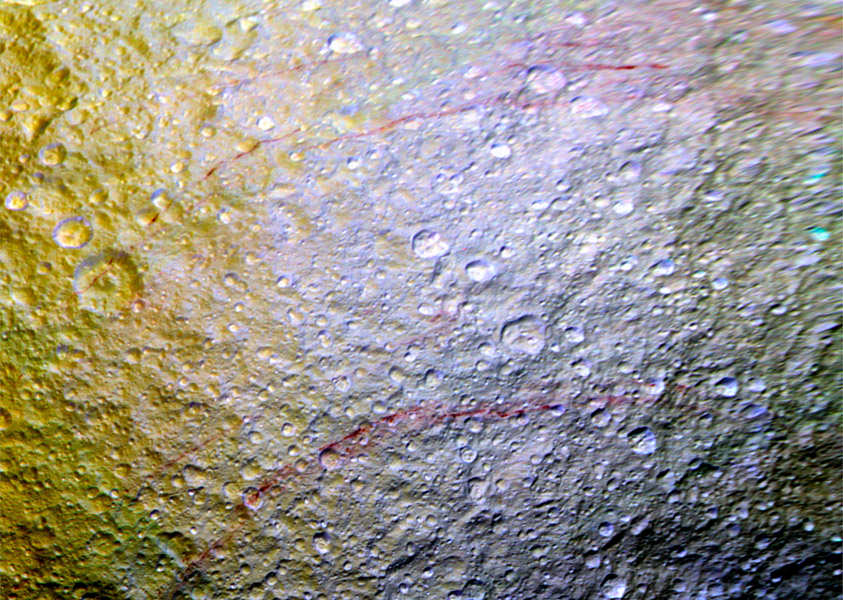
Resembling what the skin on my arms looks like after giving my cat a bath, the surface of Saturn’s moon Tethys is seen above in an extended-color composite from NASA’s Cassini spacecraft showing strange long red streaks. They stretch for long distances across the moon’s surface following the rugged terrain, continuing unbroken over hills and down into craters… and their cause isn’t yet known.
According to a NASA news release, “The origin of the features and their reddish color is currently a mystery to Cassini scientists. Possibilities being studied include ideas that the reddish material is exposed ice with chemical impurities, or the result of outgassing from inside Tethys. The streaks could also be associated with features like fractures that are below the resolution of the available images.”
The images were taken by Cassini during a flyby of the 660-mile-wide (1,062 km) Tethys on April 11, 2015 at a resolution of about 2,300 feet (700 meters) per pixel. They were acquired in visible green, infrared, and ultraviolet light wavelengths and so the composite image reveals colors our eyes can’t directly perceive. The combination of this and the solar illumination needed to image this particular area as the spacecraft passed by are why these features haven’t been seen so well until now.
“The red arcs really popped out when we saw the new images,” said Cassini participating scientist Paul Schenk of the Lunar and Planetary Institute in Houston. “It’s surprising how extensive these features are.”
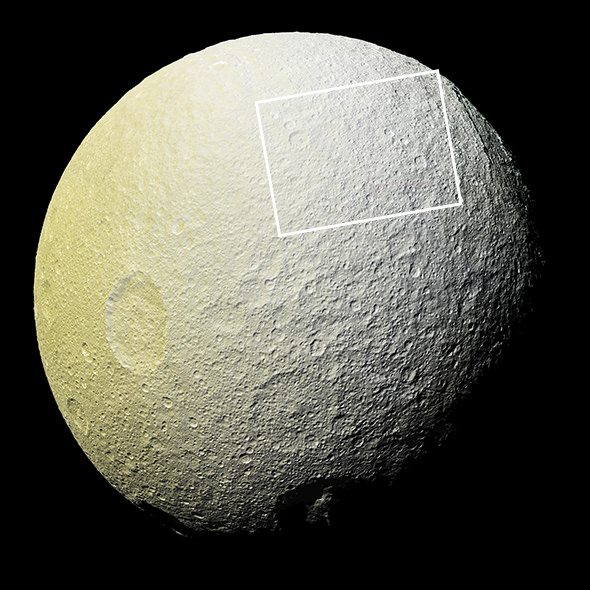
While the nature of Tethys’ streaks isn’t understood, the observations do indicate a relatively young age compared to the surrounding surface.
“The red arcs must be geologically young because they cut across older features like impact craters, but we don’t know their age in years.” said Paul Helfenstein, a Cassini imaging scientist at Cornell University in Ithaca. “If the stain is only a thin, colored veneer on the icy soil, exposure to the space environment at Tethys’ surface might erase them on relatively short time scales.”
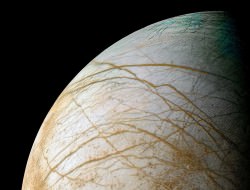
Could these arcs be signs of an underground ocean or reservoir of briny liquid, like Enceladus’ tiger stripes (aka sulcae) or the streaks that crisscross Europa’s ice? Or are they the results of infalling material from one of Saturn’s other moons? More observations with Cassini, now in its eleventh year in orbit at Saturn, are being planned to “study the streaks.”
“We are planning an even closer look at one of the Tethys red arcs in November to see if we can tease out the source and composition of these unusual markings,” said Linda Spilker, Cassini project scientist at JPL.
Source: NASA JPL
Eris’ Moon Dysnomia
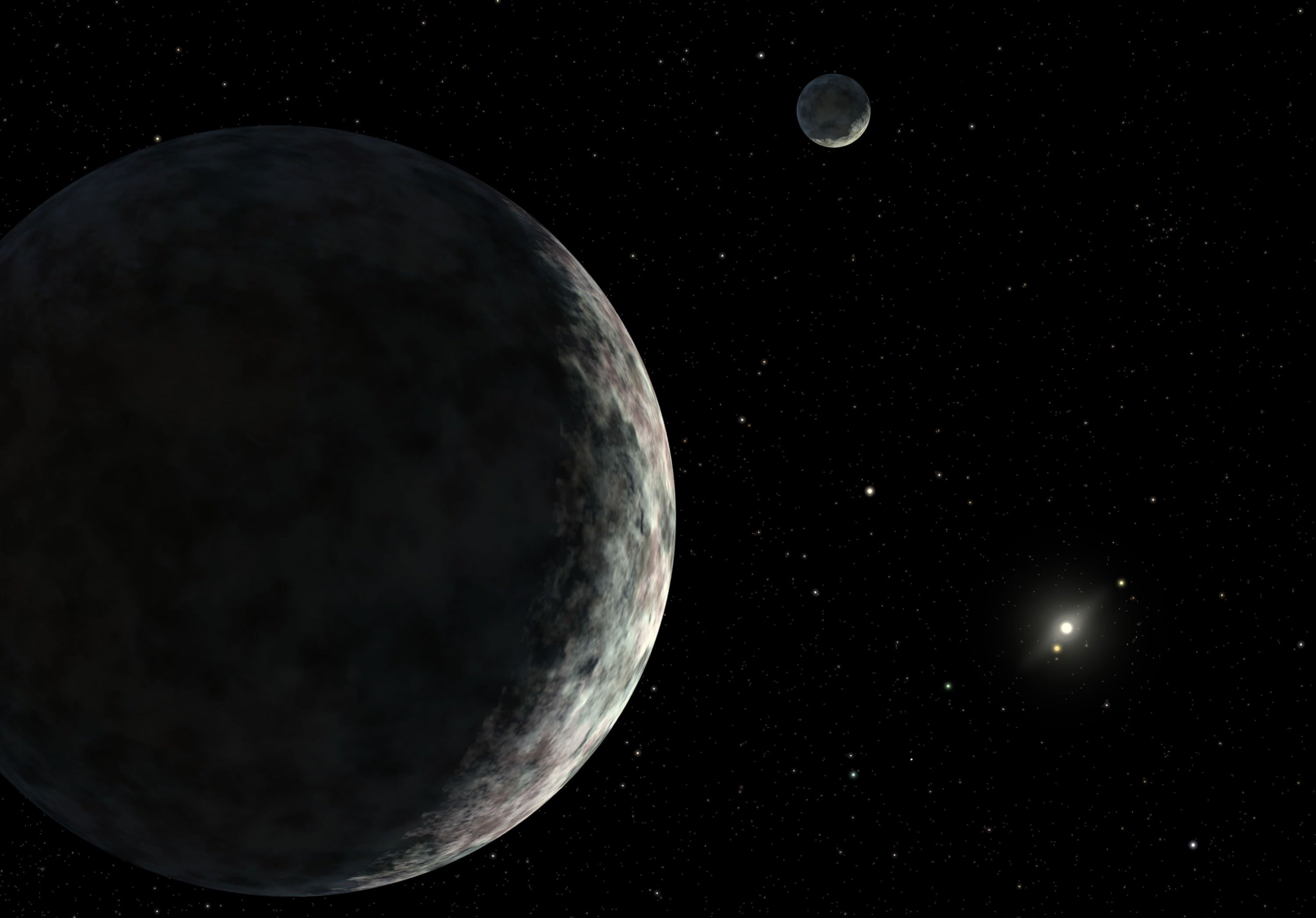
Ask a person what Dysnomia refers to, and they might venture that it’s a medical condition. In truth, they would be correct. But in addition to being a condition that affects the memory (where people have a hard time remembering words and names), it is also the only known moon of the distant dwarf planet Eris.
In fact, the same team that discovered Eris a decade ago – a discovery that threw our entire notion of what constitutes a planet into question – also discovered a moon circling it shortly thereafter. As the only satellite that circles one of the most distant objects in our Solar System, much of what we know about this ball of ice is still subject to debate.
Discovery and Naming:
In January of 2005, astronomer Mike Brown and his team discovered Eris using the new laser guide star adaptive optics system at the W. M. Keck Observatory in Hawaii. By September, Brown and his team were conducting observations of the four brightest Kuiper Belt Objects – which at that point included Pluto, Makemake, Haumea, and Eris – and found indications of an object orbiting Eris.
Provisionally, this body was designated S/2005 1 (2003 UB³¹³). However, in keeping with the Xena nickname that his team was already using for Eris, Brown and his colleagues nicknamed the moon “Gabrielle” after Xena’s sidekick. Later, Brown selected the official name of Dysnomia for the moon, which seemed appropriate for a number of reasons.
For one, this name is derived from the daughter of the Greek god Eris – a daemon who represented the spirit of lawlessness – which was in keeping with the tradition of naming moons after lesser gods associated with the primary god. It also seemed appropriate since the “lawless” aspect called to mind actress Lucy Lawless, who portrayed Xena on television. However, it was not until the IAU’s resolution on what defined a planet – passed in August of 2006 – that the planet was officially designated as Dysnomia.
Size, Mass and Orbit:
The actual size of Dysnomia is subject to dispute, and estimates are based largely on the planet’s albedo relative to Eris. For example, the IAU and Johnston’s Asteroids with Satellites Database estimate that it is 4.43 magnitudes fainter than Eris and has an approximate diameter of between 350 and 490 km (217 – 304 miles)
However, Brown and his colleagues have stated that their observations indicate it to be 500 times fainter and between 100 and 250 km (62 – 155 miles) in diameter. Using the Herschel Space Observatory in 2012, Spanish astronomer Pablo Santo Sanz and his team determined that, provided Dysnomia has an albedo five times that of Eris, it is likely to be 685±50 km in diameter.
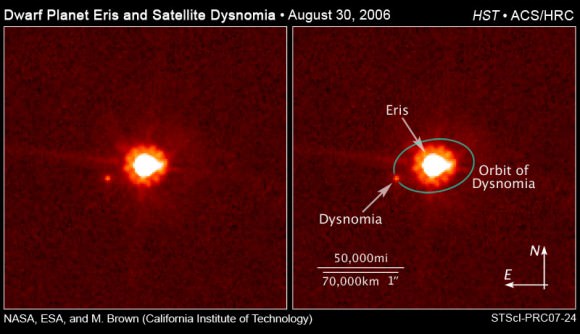
In 2007, Brown and his team also combined Keck and Hubble observations to determine the mass of Eris, and estimate the orbital parameters of the system. From their calculations, they determined that Dysnomia’s orbital period is approximately 15.77 days. These observations also indicated that Dysnomia has a circular orbit around Eris, with a radius of 37350±140 km. In addition to being a satellite of a dwarf planet, Dysnomia is also a Kuiper Belt Object (KBO) like Eris.
Composition and Origin:
Currently, there is no direct evidence to indicate what Dysnomia is made of. However, based on observations made of other Kuiper Belt Objects, it is widely believed that Dysnomia is composed primarily of ice. This is based largely on infrared observations made of Haumea (2003 EL61), the fourth largest object in the Kuiper Belt (after Eris, Pluto and Makemake) which appears to be made entirely of frozen water.
Astronomers now know that three of the four brightest KBOs – Pluto, Eris and Haumea – have one or more satellites. Meanwhile, of the fainter members, only about 10% are known to have satellites. This is believed to imply that collisions between large KBOs have been frequent in the past. Impacts between bodies of the order of 1000 km across would throw off large amounts of material that would coalesce into a moon.
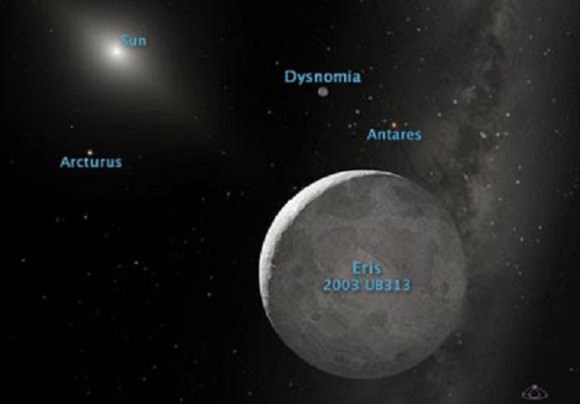
This could mean that Dysnomia was the result of a collision between Eris and a large KBO. After the impact, the icy material and other trace elements that made up the object would have evaporated and been ejected into orbit around Eris, where it then re-accumulated to form Dysnomia. A similar mechanism is believed to have led to the formation of the Moon when Earth was struck by a giant impactor early in the history of the Solar System.
Since its discovery, Eris has lived up to its namesake by stirring things up. However, it has also helped astronomers to learn many things about this distant region of the Solar System. As already mentioned, astronomers have used Dysnomia to estimate the mass of Eris, which in turn helped them to compare it to Pluto.
While astronomers already knew that Eris was bigger than Pluto, but they did not know whether it was more massive. This they did by measuring the distance between Dysnomia and how long it takes to orbit Eris. Using this method, astronomers were able to discover that Eris is 27% more massive than Pluto is.
With this knowledge in hand, the IAU then realized that either Eris needed to be classified as a planet, or that the term “planet” itself needed to be refined. Ergo, one could make that case that it was the discovery of Dysnomia more than Eris that led to Pluto no longer being designated a planet.
Universe Today has articles on Xena named Eris and The Dwarf Planet Eris. For more information, check out Dysnomia and dwarf planet outweighs Pluto.
Astronomy Cast has an episode on Pluto’s planetary identity crisis.
Sources:
New Horizons Mission to Pluto
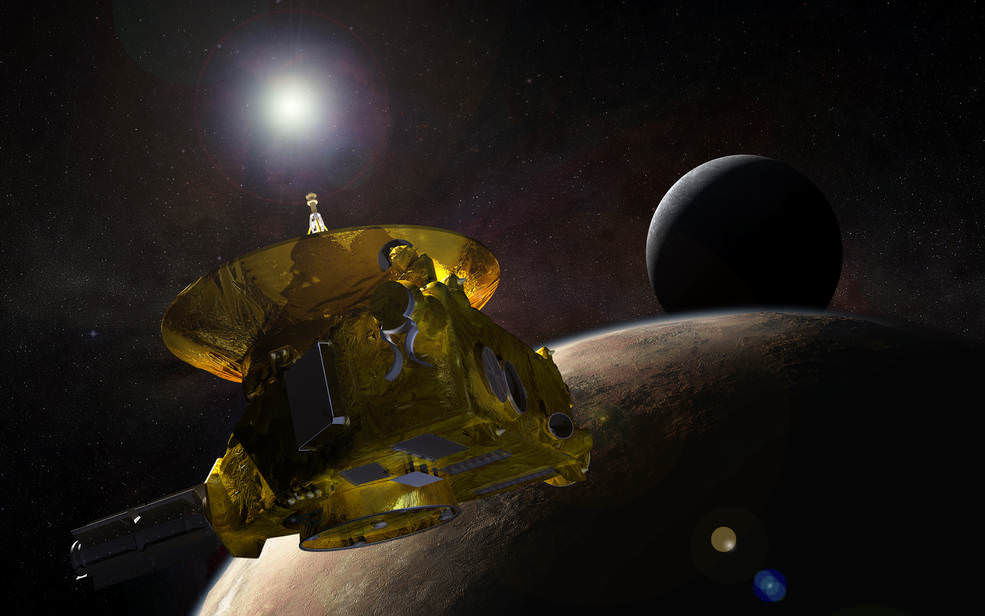
Humans have been sending spacecraft to other planets, as well as asteroid and comets, for decades. But rarely have any of these ventured into the outer reaches of our Solar System. In fact, the last time a probe reached beyond the orbit of Saturn to explore the worlds of Neptune, Uranus, Pluto and beyond was with the Voyager 2 mission, which concluded back in 1989.
But with the New Horizons mission, humanity is once again peering into the outer Solar System and learning much about its planets, dwarf planets, planetoids, moons and assorted objects. And as of July 14th, 2015, it made its historic rendezvous with Pluto, a world that has continued to surprise and mystify astronomers since it was first discovered.
Background:
In 1980, after Voyager 1‘s flyby of Saturn, NASA scientists began to consider the possibility of using Saturn to slingshot the probe towards Pluto to conduct a flyby by 1986. This would not be the case, as NASA decided instead to conduct a flyby of Saturn’s moon of Titan – which they considered to be a more scientific objective – thus making a slingshot towards Pluto impossible.
Because no mission to Pluto was planned by any space agency at the time, it would be years before any missions to Pluto could be contemplated. However, after Voyager 2′s flyby of Neptune and Triton in 1989, scientists once again began contemplating a mission that would take a spacecraft to Pluto for the sake of studying the Kuiper Belt and Kuiper Belt Objects (KBOs).
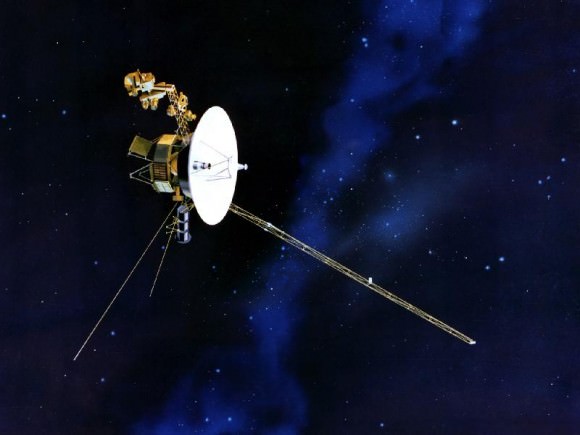
In May 1989, a group of scientists, including Alan Stern and Fran Bagenal, formed an alliance called the “Pluto Underground”. Committed to the idea of mounting an exploratory mission to Pluto and the Kuiper Belt, this group began lobbying NASA and the US government to make it this plan a reality. Combined with pressure from the scientific community at large, NASA began looking into mission concepts by 1990.
During the course of the late 1990s, a number of Trans-Neptunian Objects (TNOs) were discovered, confirming the existence of the Kuiper Belt and spurring interest in a mission to the region. This led NASA to instruct the JPL to re-purpose the mission as a Pluto and KBO flyby. However, the mission was scrapped by 2000, owing to budget constraints.
Backlash over the cancellation led NASA’s Science Mission Directorate to create the New Frontiers program which began accepting mission proposals. Stamatios “Tom” Krimigis, head of the Applied Physics Laboratory’s (APL) space division, came together with Alan Stern to form the New Horizons team. Their proposal was selected from a number of submissions, and officially selected for funding by the New Frontiers program in Nov. 2001.
Despite additional squabbles over funding with the Bush administration, renewed pressure from the scientific community allowed the New Horizons team managed to secure their funding by the summer of 2002. With a commitment of $650 million for the next fourteen years, Stern’s team was finally able to start building the spacecraft and its instruments.
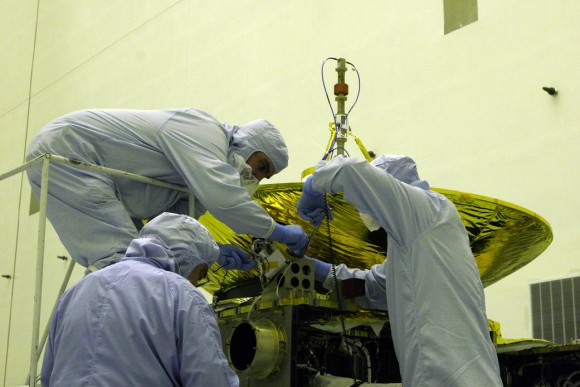
Mission Profile:
New Horizons was planned as a voyage to the only unexplored planet in the Solar System, and was originally slated for launch in January 2006 and arrival at Pluto in 2015. Alan Stern was selected as the mission’s principal investigator, and construction of the spacecraft was handled primarily by the Southwest Research Institute (SwRI) and the Johns Hopkins Applied Physics Laboratory, with various contractor facilities involved in the navigation of the spacecraft.
Meanwhile, the US Naval Observatory (USNO) Flagstaff Station – in conjunction with NASA and JPL – was responsible for performing navigational position data and related celestial frames. Coincidentally, the UNSO Flagstaff station was where the photographic plates that led to the discovery of Pluto’s moon Charon came from.
In addition to its compliment of scientific instruments (listed below), there are several cultural artifacts traveling aboard the spacecraft. These include a collection of 434,738 names stored on a compact disc, a piece of Scaled Composites’s SpaceShipOne, and a flag of the USA, along with other mementos. In addition, about 30 g (1 oz) of Clyde Tombaugh’s ashes are aboard the spacecraft, to commemorate his discovery of Pluto in 1930.
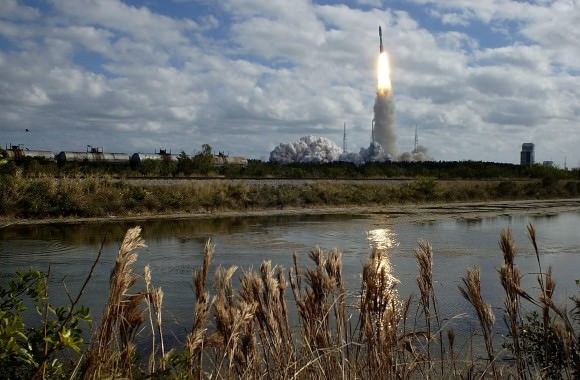
Instrumentation:
The New Horizons science payload consists of seven instruments. They are (in alphabetically order):
- Alice: An ultraviolet imaging spectrometer responsible for analyzing composition and structure of Pluto’s atmosphere and looks for atmospheres around Charon and Kuiper Belt Objects (KBOs).
- LORRI: (Long Range Reconnaissance Imager) a telescopic camera that obtains encounter data at long distances, maps Pluto’s farside and provides high resolution geologic data.
- PEPSSI: (Pluto Energetic Particle Spectrometer Science Investigation) an energetic particle spectrometer which measures the composition and density of plasma (ions) escaping from Pluto’s atmosphere.
- Ralph: A visible and infrared imager/spectrometer that provides color, composition and thermal maps.
- REX: (Radio Science EXperiment) a device that measures atmospheric composition and temperature; passive radiometer.
- SDC: (Student Dust Counter) built and operated by students, this instrument measures the space dust peppering New Horizons during its voyage across the solar system.
- SWAP: (Solar Wind Around Pluto) a solar wind and plasma spectrometer that measures atmospheric “escape rate” and observes Pluto’s interaction with solar wind.
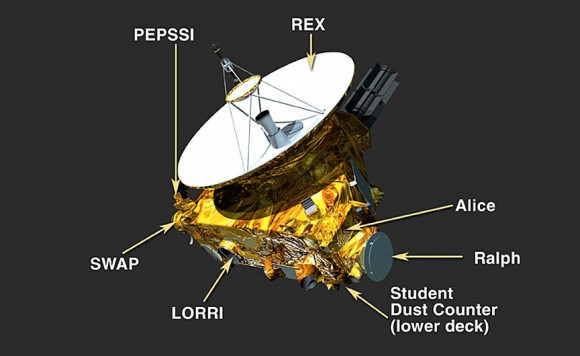
Launch:
Due to a series of weather-related delays, the New Horizons mission launched on January 19th, 2006, two days later than originally scheduled. The spacecraft took off from Cape Canaveral Air Force Station, Florida, at 15:00 EST (19:00 UTC) atop an Atlas V 551 rocket. This was the first launch of this particular rocket configuration, which has a third stage added to increase the heliocentric (escape) speed.
The spacecraft left Earth faster than any spacecraft to date, achieving a launch velocity of 16.5 km/s. It took only nine hours to reach the Moon’s orbit, passing lunar orbit before midnight (EST) on the same day it was launched. It has not, however, broken Voyager 1‘s record – which is currently traveling at 17.145 km/s (61,720 km/h, 38,350 mph) relative to the Sun – for being the fastest spacecraft to leave the Solar System.
Inner Solar System:
Between January and March, 2006, mission controllers guided the probe through a series of trajectory-correction maneuvers (TCMs). During the week of February 20th, 2006, controllers conducted in-flight tests on three of the major on board science instruments. On April 7th, the spacecraft passed the orbit of Mars, moving at roughly 21 km/s (76,000 km/h; 47,000 mph) away from the Sun.
At this point in its journey, the spacecraft had reached a distance of 243 million kilometers from the Sun, and approximately 93.4 million km from Earth. On June 13th, 2006, the New Horizons spacecraft passed the tiny asteroid 132524 APL at a distance of 101,867 km (63,297 mi) when it was closest.
Using the Ralph instrument, New Horizons was able to capture images of the asteroid, estimating to be 2.5 km (1.6 mi) in diameter. The spacecraft also successfully tracked the asteroid from June 10th-12th, 2006, allowing the mission team to test the spacecraft’s ability to track rapidly moving objects.

From September 21st-24th, New Horizons managed to capture its first images of Pluto while testing the LORRI instruments. These images, which were taken from a distance of approximately 4,200,000,000 km (2.6×109 mi) or 28.07 AU and released on November 28th, confirmed the spacecraft’s ability to track distant targets.
Outer Solar System:
On September 4th, 2006, New Horizons took its first pictures of Jupiter at a distance of 291 million kilometers (181 million miles). The following January, it conducted more detailed surveys of the system, capturing an infrared image of the moon Callisto, and several black and white images of Jupiter itself.
By February 28th, 2007, at 23:17 EST (03:17, UTC) New Horizons made its closest approach to Europa, at a distance of 2,964,860 km (1,842,278 mi). At 01:53:40 EST (05:43:40 UTC), the spacecraft made its flyby of Jupiter, at a distance of 2.3 million km (1.4 million mi) and received a gravity assist.
The Jupiter flyby increased New Horizons‘ speed by 4 km/s (14,000 km/h; 9,000 mph), accelerating the probe to a velocity of 23 km/s (83,000 km/h; 51,000 mph) relative to the Sun and shortening its voyage to Pluto by three years.
The encounter with Jupiter not only provided NASA with the opportunity to photograph the planet using the latest equipment, it also served as a dress rehearsal for the spacecraft’s encounter with Pluto. As well as testing the imaging instruments, it also allowed the mission team to test the communications link and the spacecraft’s memory buffer.
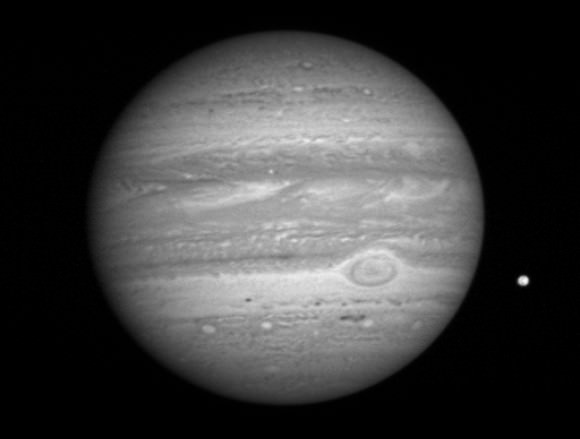
One of the main goals during the Jupiter encounter was observing its atmospheric conditions and analyzing the structure and composition of its clouds. Heat-induced lightning strikes in the polar regions and evidence of violent storm activity were both observed. In addition, the Little Red Spot, was imaged from up close for the first time. The New Horizons spacecraft also took detailed images of Jupiter’s faint ring system. Traveling through Jupiter’s magnetosphere, the spacecraft also managed to collect valuable particle readings.
The flyby of the Jovian systems also gave scientists the opportunity to examine the structure and motion of Io’s famous lava plumes. New Horizons measured the plumes coming from the Tvashtar volcano, which reached an altitude of up to 330 km from the surface, while infrared signatures confirmed the presence of 36 more volcanoes on the moon.
Callisto’s surface was also analyzed with LEISA, revealing how lighting and viewing conditions affect infrared spectrum readings of its surface water ice. Data gathered on minor moons such as Amalthea also allowed NASA scientists to refine their orbit solutions.
After passing Jupiter, New Horizons spent most of its journey towards Pluto in hibernation mode. During this time, New Horizons crossed the orbit of Saturn (June 8, 2008) and Uranus on (March 18, 2011). In June 2014, the spacecraft emerged from hibernation and the team began conducting instrument calibrations and a course correction,. By August 24th, 2014, it crossed Neptune’s orbit on its way to Pluto.
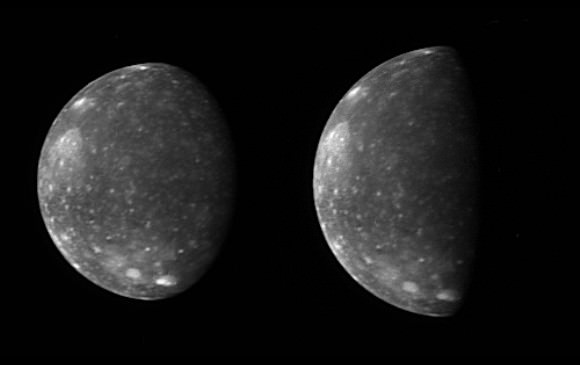
Rendezvous with Pluto:
Distant-encounter operations at Pluto began on January 4th, 2015. Between January 25th to 31st, the approaching probe took several images of Pluto, which were released by NASA on February 12th. These photos, which were taken at a distance of more than 203,000,000 km (126,000,000 mi) showed Pluto and its largest moon, Charon.
Investigators compiled a series of images of the moons Nix and Hydra taken from January 27th through February 8th, 2015, beginning at a range of 201,000,000 km (125,000,000 mi), while Kerberos and Styx were captured by photos taken on April 25.
On July 4th, 2015, NASA lost contact with New Horizons after it experienced a software anomaly and went into safe mode. On the following day, NASA announced that they had determined it to be the result of a timing flaw in a command sequence. By July 6th, the glitch had been fixed and the probe had exited safe mode and began making its approach.
The New Horizons spacecraft made its closest approach to Pluto at 07:49:57 EDT (11:49:57 UTC) on July 14th, 2015, and then Charon at 08:03:50 EDT (12:03:50 UTC). Telemetries confirming a successful flyby and a healthy spacecraft reached Earth on 20:52:37 EDT (00:52:37 UTC).
During the flyby, the probe captured the clearest pictures of Pluto to date, and full analyses of the data obtained is expected to take years to process. The spacecraft is currently traveling at a speed of 14.52 km/s (9.02 mi/s) relative to the Sun and at 13.77 km/s (8.56 mi/s) relative to Pluto.
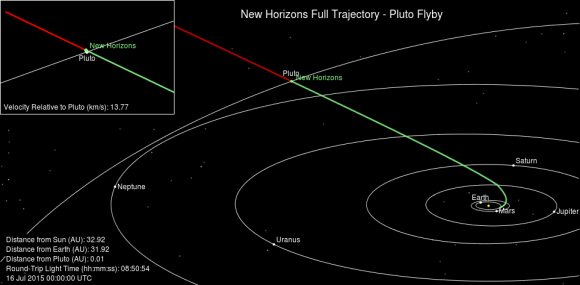
Future Objectives:
With its flyby of Pluto now complete, the New Horizons probe is now on its way towards the Kuiper Belt. The goal here is to study one or two other Kuiper Belt Objects, provided suitable KBOs are close to New Horizons‘ flight path.
Three objects have since been selected as potential targets, which were provisionally designated PT1 (“potential target 1”), PT2 and PT3 by the New Horizons team. These have since been re-designated as 2014 MU69 (PT1), 2014 OS393 (PT2), and 2014 PN70 (PT3).
All of these objects have an estimated diameter of 30–55 km, are too small to be seen by ground telescopes, and are 43–44 AU from the Sun, which would put the encounters in the 2018–2019 period. All are members of the “cold” (low-inclination, low-eccentricity) classical Kuiper Belt, and thus very different from Pluto.
Even though it was launched far faster than any outward probe before it, New Horizons will never overtake either Voyager 1 or Voyager 2 as the most distant human-made object from Earth. But then again, it doesn’t need to, given that what it was sent out to study all lies closer to home.
What’s more, the probe has provided astronomers with extensive and updated data on many of planets and moons in our Solar System – not the least of which are the Jovian and Plutonian systems. And last, but certainly not least, New Horizons is the first spacecraft to have it made it out to such a distance since the Voyager program.
And so we say so long and good luck to New Horizons, not to mention thanks for providing us with the best images of Pluto anyone has ever seen! We can only hope she fares well as she makes its way into the Kuiper Belt and advances our knowledge of the outer Solar System even farther.
We have many interesting articles about the New Horizons spacecraft and Pluto here on Universe Today. For example, here are some Interesting Facts About Pluto, How Long Does it Take to Get to Pluto, Why Pluto is No Longer Considered a Planet, and Is There Life on Pluto?
For more information on the Kuiper Belt, check out What is The Kuiper Belt? and NASA’s Solar System Exploration entry on the Kuiper Belt and Oort Cloud.
Astronomy Cast also has some fascinating episodes on Pluto, including On Pluto’s Doorstep – Live Hangout with New Horizons Team
And be sure to check out the New Horizons mission homepage at NASA.
Charon: Pluto’s Largest Moon
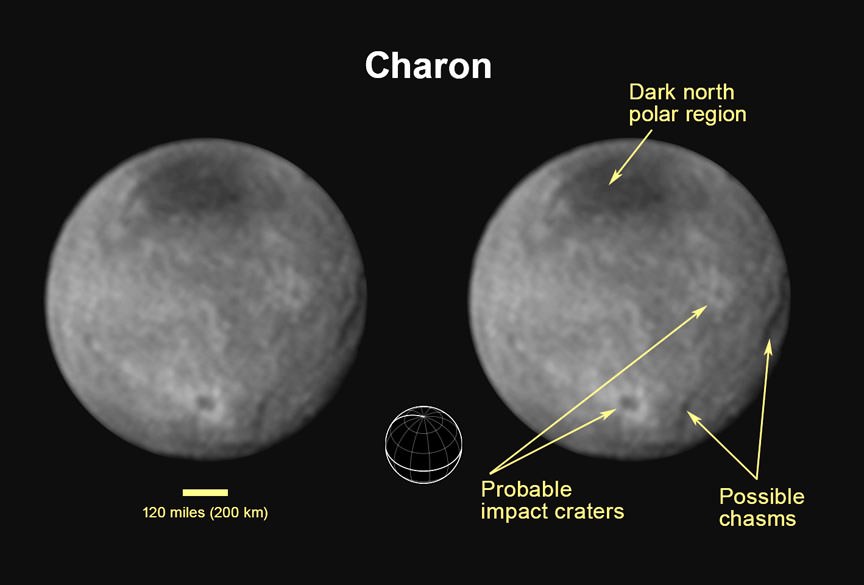
Beginning in 1978, astronomers began to discover that Pluto – the most distant known object from the Sun (at the time) – had its own moons. What had once been thought to be a solitary body occupying the outer edge of our Solar System suddenly appeared to have a system with a large moon Charon. And as time went on, a total of four moons would be discovered.
Of these, Charon is the largest and most easily observed, hence why it was discovered first. In addition to being the biggest of its peers, its also quite large in comparison to Pluto. As such, Charon has always had something of a unique relationship with its parent body, and stands apart as far as objects in the outer Solar System are concerned.
How Fast is Gravity?
How long would it take for the gravitational well created by the Sun to disappear, and the Earth and the rest of the planets fly off into space?
In the very first episode of the Guide to Space, a clean shaven version of me, hunched over in my basement explained how long it takes for light to get from the Sun to the Earth. To answer that question, it takes light about 8 minutes and 20 seconds to make the trip.
In other words, if the Sun suddenly disappeared from space itself, we’d still see it shining in the sky for over 8 minutes before the everything went dark. Martians would take about 12 minutes to notice the Sun was gone, and New Horizons which is nearly at Pluto wouldn’t see a change for over 4 hours.
Although this idea is a little mind-bending, I’m sure you’ve got your head wrapped around it. We’ve sure gone on about it here on this show. The further you look into space, the further you’re looking back in time because of the speed of light, but have you ever considered the speed of gravity?
Let’s go back to that original example and remove the Sun again. How long would it take for the gravitational well created by the Sun to disappear.
When would the Earth and the rest of the planets fly off into space without the Sun holding the whole Solar System together with its gravity? Would it happen instantly, or would it take time for the information to reach Earth?
It sounds like a simple question, but it’s actually really tough to tell. The force of gravity, compared to other forces in the Universe, is actually pretty weak. It’s practically impossible to test in the laboratory.
According to Einstein’s Theory of Relativity, distortions in spacetime caused by mass – also known as gravity – will propagate out at the speed of light. In other words, the light from the Sun and the gravity of the Sun should disappear at exactly the same time from the Earth’s perspective.
But that’s just a theory and a bunch of fancy math. Is there any way to test this out in reality? Astronomers have figured a way to deduce this indirectly by watching the interactions with massive objects in space.
In the binary system PSR 1913+16, there’s a pair of pulsars orbiting each other within just a few times bigger than the width of the Sun. As they spin around each other, the pulsars warp the spacetime themselves by releasing gravitational waves. And this release of gravitational waves causes the pulsars to slow down.
It’s amazing that astronomers can even measure this orbital decay, but the even more amazing part is that they use this process to measure the speed of gravity. When they did the calculations, astronomers determined the speed of gravity to be within 1% of the speed of light – that’s close enough.
Scientists have also used careful observations of Jupiter to get at this number. By watching how Jupiter’s gravity warps the light from a background quasar as it passes in front, they were able to determine that the speed of gravity is between 80% and 120% of the speed of light. Again, that’s close enough.
So there you go. The speed of gravity equals the speed of light. And should the Sun suddenly disappear, we’ll be glad to get all the bad news at the same time.
Gravity is a harsh mistress. Tell us a story about a time gravity was too fast for you. Put it in the comments below.





